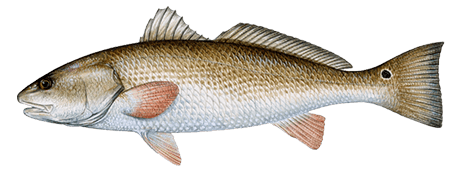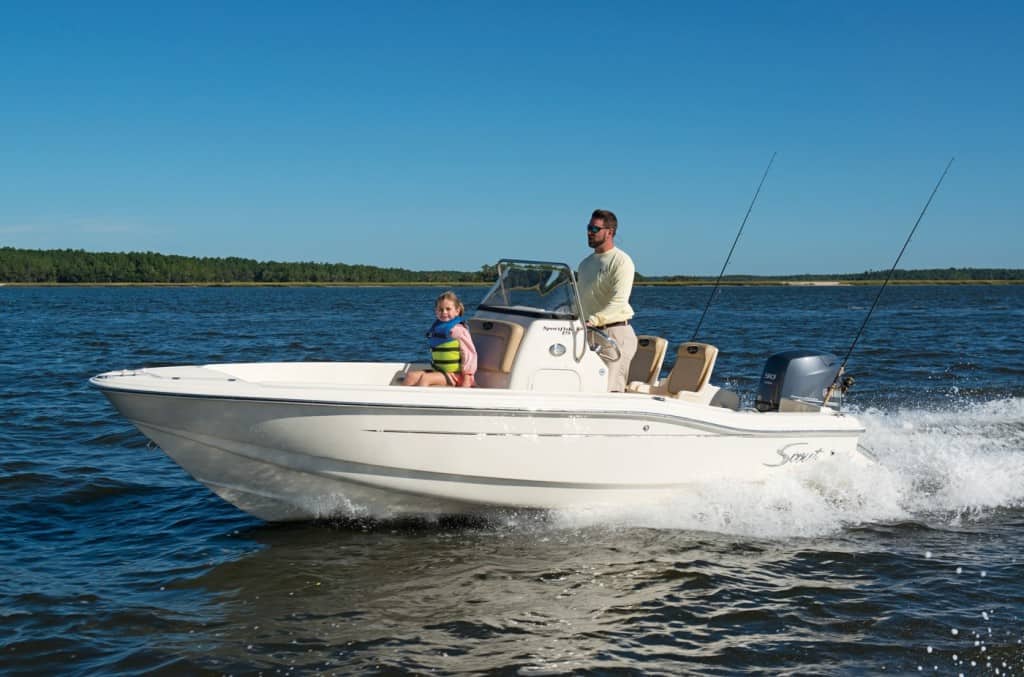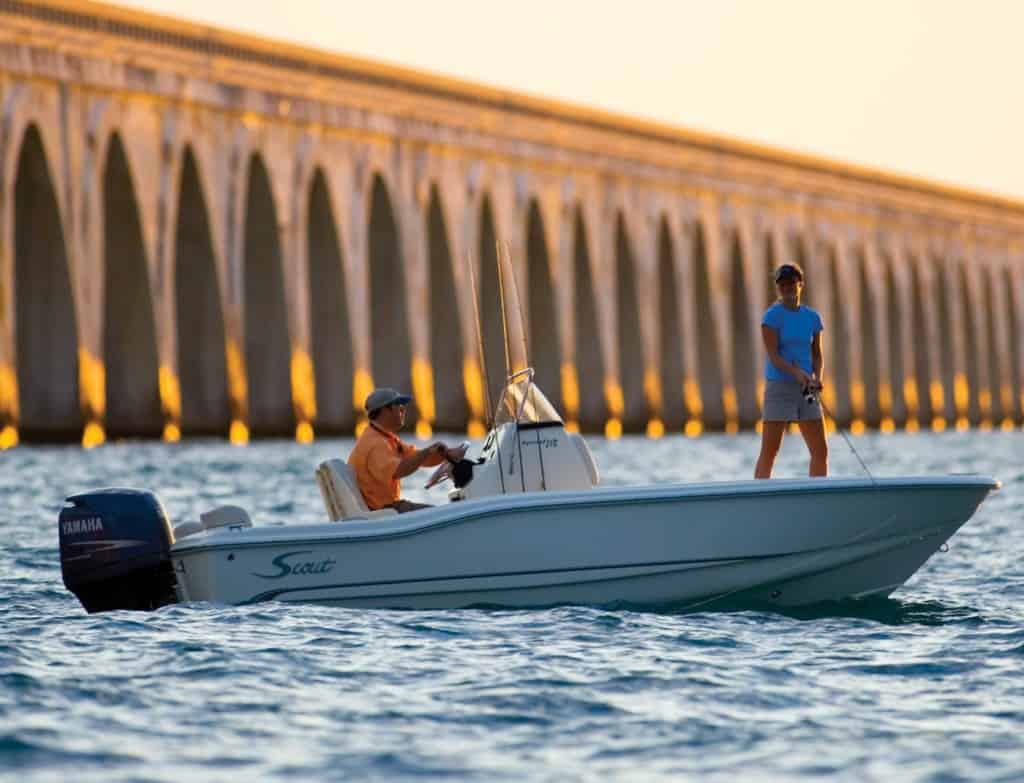
With the wind whipping across the deck, the trolling motor keeping the nose of the boat pointed toward the redfish we are pursuing with fly rods in hand, this has the makings of a fine day.
The Gurgler– a fly made of foam, flash, and hair–landed perfectly before the lumbering redfish. In a quick twitch of his head, he inhaled the small fly and began to seek deeper water. I stripped the line until all that could be felt was the forty-pound red on the other end. With a quick snatch of the line, the red exploded, and the fight was on.
No wonder everyone in the state of Texas is obsessed with redfish on a fly.
All About Redfish
Redfish, or red drum, are a popular sportfish that cruise the coastal waters of the Atlantic coast and the Gulf of Mexico. Though they are generally caught in saltwater, they will commonly reach weights of 20 to 40 pounds. The size of this inshore fish and their relative accessibility is a recipe for exciting saltwater sportfishing.
Redfish are also unique as they almost all have a somewhat unique black spot on their tail. This spot(s) differs for every redfish and sometimes can be used to identify a fish caught prior. Sometimes they have more than one spot, but rarely no spot.
Where to Find Redfish
Redfish are commonly found anywhere on the Atlantic and Gulf of Mexico coasts. However, they are more popular in the southern half of the Atlantic and the Louisiana and Texas parts of the Gulf. This is due to the lower latitudes leading to warmer waters and bigger fish.
While redfish will go to deep waters like any other fish, they are primarily shallow-water fish that love to scavenge off the bottom. They will chase small baitfish into shallow areas where they can avoid predation by dolphins and other predators and still be able to feast on high-protein baitfish.

Packing the Tacklebox
Like any type of fishing, getting your tackle figured out is the first step to success. While redfish don’t require anything overly specialized or expensive, there are considerations you need to take into account before setting out after them.
Rods—Redfish will vary in size depending on whether you are fishing in the Atlantic or Gulf of Mexico. With variability comes the demand for different-sized rods. Depending on conditions, if you find yourself in the Gulf, where the fish tend to get larger, you will need a 9wt or 10wt rod. In the Atlantic, you can get away with a smaller rod to make accurate presentations with smaller flies.
Reels— Redfish are powerful fish but aren’t known for excessively long, high-intensity fights like other blue water species. You will fish all day for a few quality bites. When fishing for redfish, you must consider the fatigue that will begin to set in your casting arm. Having a reel that is both lightweight, of sufficient saltwater durability, and has a moderate drag is a must when seriously pursuing redfish. You should have a strong bias for a high-quality reel that is lightweight.
Leaders—Your leader configuration will vary depending on the conditions in which you are pursuing redfish. When feeding, they are extremely alert and easy to alarm. Therefore, you need to tailor your leader length to be long enough to be well outside of their visual range. You can get by with a shorter leader if you are fishing in muddy water. Instead, in clear water, you will want more stand-off distance. Typically, this will land you between seven and ten feet of leader at the end of your fly line.
Flies— Fly choice will vary depending on where and when you chase redfish. The most important thing to remember is to adapt your presentation and fly selection based on what the redfish appear to be feeding on. Many times this will result in going to classic baitfish imitators patterns like a Clouser Minnow or a Lefty’s Deceiver. However, an EP Shrimp can do exceptionally well during the early spring and when shrimp are in vogue. Another pattern that deserves attention is the Gurgler. Since it is a topwater fly, a strike on it can be extremely exciting to watch and leave you addicted to catching redfish.
Hooks— Like fly selection, “it depends” is the best way to answer what hook size you will need to be successful. The best option is to match your fly size to the size of the food source the redfish are feeding on. If they are chasing small baitfish, a 6-8 size hook will be ideal. However, if they have taken to chasing larger fish or you are expecting to encounter thirty-pound fish, a 1/0 or 2/0 could be a perfect size.
Tips for Catching Redfish on a Fly
Smooth is Slow- Though they will behave like predators, redfish come from a family of bottom feeders. With that being the case, they simply aren’t built for chasing agile baitfish at high speed. Instead, they prefer to scavenge on the weak and injured. Slowly strip your fly in, making tiny twitches to look like a dying fish.
Feel Them Out- If you detect a strike, easily pull all the slack out of the line and verify the fish has the fly in his mouth. Once you have done that, set the hook with your stripping hand before you raise the rod. This will help the fly get a solid hook set since the angle of the pull will come from a more horizontal angle rather than a vertical one.
Practice Casting- Redfish are often the target of dolphins, birds of prey, and other predators. As a result, they are extremely skittish. One way to ensure a proper presentation that won’t scare the fish away is to cast from as far away as you possibly can accurately. In your yard, place a coffee cup fifty feet in front of you. Once you can cast a fly directly into that cup, step back another ten feet and repeat the process. If you can accurately cast into a coffee cup at extreme distances, putting a fly in front of a redfish will be no problem.
Catching Redfish with Scout Boats

Redfish are some of the most popular saltwater fish being chased by fly fisherman today for their table fare, challenge, and explosive fights. Additionally, they are often in shallow flats that allow the angler the pleasure of seeing the fish take the fly. Yet, those flats are often inaccessible to many traditional saltwater boats.
That’s why Scout Boats has engineered the perfect redfish boat. With the Sportfish 175 you have enough room to cast from the deck while not drafting too much to get into the shallow flats that redfish love. Then in the comfort of the captain’s chairs, you can enjoy the high speed and range you need to reach hidden fisheries quickly.

